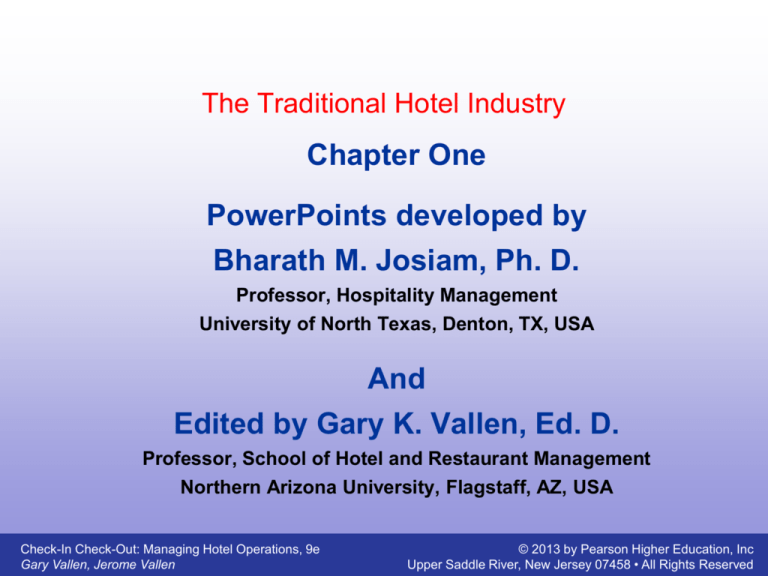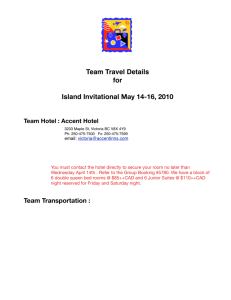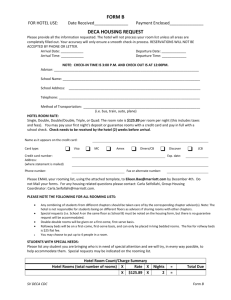
The Traditional Hotel Industry
Chapter One
PowerPoints developed by
Bharath M. Josiam, Ph. D.
Professor, Hospitality Management
University of North Texas, Denton, TX, USA
And
Edited by Gary K. Vallen, Ed. D.
Professor, School of Hotel and Restaurant Management
Northern Arizona University, Flagstaff, AZ, USA
Check-In Check-Out: Managing Hotel Operations, 9e
Gary Vallen, Jerome Vallen
© 2013 by Pearson Higher Education, Inc
Upper Saddle River, New Jersey 07458 • All Rights Reserved
Objectives of Chapter 1
• Understand the historical evolution of the hotel industry
• Appreciate the size and scope of the industry and its
products
• Be able to understand and compute:
–
–
–
–
Occupancy
Average Daily Room Rate (ADR)
Revenue per Available Room (REVPAR)
Double Occupancy
• Understand Hotel Classification Systems
• Start to understand industry terms/jargons
Check-In Check-Out: Managing Hotel Operations, 9e
Gary Vallen, Jerome Vallen
© 2013 by Pearson Higher Education, Inc
Upper Saddle River, New Jersey 07458 • All Rights Reserved
History of Hotel Keeping
•
•
•
•
•
Hotels have been around for centuries
Worldwide – Rome, China, Middle-East
Europe
Stagecoach Inns of USA
Hotels becoming larger in recent years
– Simply not possible 75 years ago
• Hotels always served meals in the past
– Travelers had no other options then
• Now many hotels have limited/no food service
– Other options available to travelers now
Check-In Check-Out: Managing Hotel Operations, 9e
Gary Vallen, Jerome Vallen
© 2013 by Pearson Higher Education, Inc
Upper Saddle River, New Jersey 07458 • All Rights Reserved
History of Hotel Keeping
• Different Eras and Hotel Keeping
– Hunter/gatherer Era (Pre-historic)
• No need for hotels as travel was limited
– Agricultural Era (Early civilization onwards)
• Very limited travel by traders and officials
• Early beginnings of hotel industry with roadside inns
• Problems of safety and security
– Industrial Era (19th century onwards)
• Increasing national and international travel
• Development of bigger and better hotels start
– Service Era (Today)
• Travel for both business and pleasure is routine
• Development of sophisticated hotel industry worldwide to
cater to travelers
Check-In Check-Out: Managing Hotel Operations, 9e
Gary Vallen, Jerome Vallen
© 2013 by Pearson Higher Education, Inc
Upper Saddle River, New Jersey 07458 • All Rights Reserved
How Hotels Count and Measure
•
Occupancy Rate in Percentage
– The relationship between demand (the number of rooms actually sold) and supply (the
number of rooms available for sale)
– Measures the hotel’s “share of the market”, so it measures quantity
– Occupancy Rate in % = Rooms Sold / Rooms Available for sale
•
Sales per Occupied Room (Average Daily Rate, ADR) in $
–
–
–
–
•
The dollar amount received for each room sold
Measure the quality of the business.
Problem: What if only one room is sold, but at a high rate. ADR can be misleading.
Average Daily Rate = Room sales (measured in dollars) / Number of rooms sold
REVPAR (Revenue per Available Room) in $
– The relationship between revenue per room and the total room inventory available
– Measure how well management fills rooms, without cutting prices
– REVPAR = Room Revenues/Sales in $ / Number of rooms available for sale
•
Double Occupancy
–
–
–
–
Refers to any room in which there is more than one person
Double occupancy increases per-room revenue, if rates are per-person
In full-service hotels, double occupancy leads to more additional sales
% of double occupancy = (No. of guests – No. of rooms occupied.)/No. of rooms occ.
Check-In Check-Out: Managing Hotel Operations, 9e
Gary Vallen, Jerome Vallen
© 2013 by Pearson Higher Education, Inc
Upper Saddle River, New Jersey 07458 • All Rights Reserved
Calculating Daily Statistics – Example
Notation
Item
Hotel
(A)
Number of rooms available for sale
800
(B)
Number of rooms in the hotel
820
(C)
Number of rooms sold to guest
600
(D)
Revenue received from room sales only
(E)
Number of employees on staff
500
(F)
Number of guests
700
$48,000
Calculate the Following
Item
Hint
Hotel
Percentage of Occupancy
(C)/(A)
75%
Sales per occupied room (ADR)
(D)/(C)
$80
Revenue per available room (REVPAR)
(D)/(A)
$60
ADR*Occupancy=REVPAR
$80*75%=$60
(E)/(A)
0.625
[(F)-(C)]/(C)
16.6%
Mathematical check
Employees per guest room
Percentage of double occupancy
Check-In Check-Out: Managing Hotel Operations, 9e
Gary Vallen, Jerome Vallen
© 2013 by Pearson Higher Education, Inc
Upper Saddle River, New Jersey 07458 • All Rights Reserved
Special Characteristics of the Hotel Business
• Perishability
– At midnight, value of unsold inventory is $0
– Tomorrow we are selling tomorrow’s inventory
• Puts pressure to sell “now”
• Location
– Fixed
• Cannot move or “deliver” to high demand areas
– Changing value of fixed location
• Re-routing of highway could devastate business
– Marketing and sales promotion very important
• Need to bring customers to hotel
Check-In Check-Out: Managing Hotel Operations, 9e
Gary Vallen, Jerome Vallen
© 2013 by Pearson Higher Education, Inc
Upper Saddle River, New Jersey 07458 • All Rights Reserved
Special Characteristics of the Hotel Business
• Fixed Supply, but Varying Demand
– Example: Our hotel only has 100 rooms
• Today only 50 are sold, revenue is lost
• Tomorrow, Super Bowl in town, but I can only sell 100
rooms!
– No way to make up lost revenue
– No way to increase production to meet increased demand
Check-In Check-Out: Managing Hotel Operations, 9e
Gary Vallen, Jerome Vallen
© 2013 by Pearson Higher Education, Inc
Upper Saddle River, New Jersey 07458 • All Rights Reserved
Special Characteristics of the Hotel Business
• High Operating Costs
– Capital Intensive
• Cost per room is $50,000 to $1 million
– Labor Intensive
• Hassles of dealing with labor
• Costs of dealing with labor
– High Fixed Costs – Low Variable Costs
• Even at low/no occupancy we incur fixed costs
– Mortgage, utilities, salaries, marketing etc
• Variable costs per occupied room are low
– Cost of cleaning, replacing linen, utilities used etc.,
• Need to make or exceed Break Even Point
– High profits, once we exceed break-even point
Check-In Check-Out: Managing Hotel Operations, 9e
Gary Vallen, Jerome Vallen
© 2013 by Pearson Higher Education, Inc
Upper Saddle River, New Jersey 07458 • All Rights Reserved
Special Characteristics of the Hotel Business
• Seasonality
– Within Year
• Business fluctuates from winter to spring to summer to
fall in most hotels
– Within Month
• Business fluctuates from early to mid to late part of the
month
– Within Week
• Corporate/Downtown hotels busy on weekdays, empty
on weekends
• Leisure hotels busy on weekends, empty on weekdays
Check-In Check-Out: Managing Hotel Operations, 9e
Gary Vallen, Jerome Vallen
© 2013 by Pearson Higher Education, Inc
Upper Saddle River, New Jersey 07458 • All Rights Reserved
Special Characteristics of the Hotel Business
• Solutions to Seasonality
– Extend Season
• Have new activities and sales promotions before and after
“traditional” season to extend it.
– Seek New Markets
• Disney gets families in summer and winter holidays and
targets conventions, “empty-nesters” year round
– Location
• Open properties in areas with counter-season
– Shift employees between properties
– Mixed Use Development
• Build hotel in area with multiple sources of guests
– Westin Galleria in Dallas gets corporate crowd on weekdays
and tourist/shopper crowds on weekends
Check-In Check-Out: Managing Hotel Operations, 9e
Gary Vallen, Jerome Vallen
© 2013 by Pearson Higher Education, Inc
Upper Saddle River, New Jersey 07458 • All Rights Reserved
Hotel Classifications
• Size
– The number of available room is the standard measure of size
• Mega hotel: 1500 rooms or more
– (Exhibit 1-4)
• Large hotel: 300 rooms or more
• Medium hotel: 150 to 300 rooms
• Small hotel: 100 rooms or less
– Less than $3 million in annual sales
• Mom-and-pop hotels: Small independent roadside motels family
owned and operated
– Declining in numbers from a high of about 60,000 in the 1960s
• Class
– By Rate (Exhibit 1-6 )
• More expensive the hotel, better it is!!
– Not true always!
» $200 will get a small/medium room in Paris, France, but a great
room in Paris, TX, USA!!
» Room rate may be a function of location/real estate value, not
room itself!
- Rooms are more expensive in core downtown areas
Check-In Check-Out: Managing Hotel Operations, 9e
Gary Vallen, Jerome Vallen
© 2013 by Pearson Higher Education, Inc
Upper Saddle River, New Jersey 07458 • All Rights Reserved
• Class
Hotel Classifications
– By Level of Service
• More the services, better the hotel
– Not true always
» More services are offered where labor costs are lower
- Even small, cheap hotels in India offer room-service and money
changing service!
– By Level of Amenities
• More the amenities, better the hotel!
– Not true always!
– Different Rating Systems
• A standardized rating system allows the guest to make an
informed decision
– Systems of stars, diamonds, etc.
» Authors rating system for hotels in the USA (Exhibit 1-7)
» More the stars or diamonds, better and more expensive the hotel
• Ratings are valid only within system or country
– A “Five Star” hotel in India is not the same as a “Five Star” hotel in
France.
» Look for amenities/level of service needed to qualify!
Check-In Check-Out: Managing Hotel Operations, 9e
Gary Vallen, Jerome Vallen
© 2013 by Pearson Higher Education, Inc
Upper Saddle River, New Jersey 07458 • All Rights Reserved
Hotel Classifications
• Type
– Commercial/Business/Corporate
– Residential
• Landlord/tenant relationship between hotel and guest
– Extended-Stay
• More home-like with kitchenettes, fireplaces, laundry facilities
– Extended Stay America, Residence Inns (Marriott)
– Resort (Exhibit 1-9)
• The Megaresort- large, self-contained resorts. Multiple entertainment
and recreational facilities.
– Guests need not leave the property during their entire stay!
– Bed and Breakfast (Exhibit 1-11)
– Boutique Hotels (Exhibit 1-12)
• Small, “individual” properties that offer personalized service
– Trophy Hotels
• Big name hotels often bought for prestige rather than for profit
– Waldorf-Astoria in New York City
Check-In Check-Out: Managing Hotel Operations, 9e
Gary Vallen, Jerome Vallen
© 2013 by Pearson Higher Education, Inc
Upper Saddle River, New Jersey 07458 • All Rights Reserved
Hotel Classifications
• Plan
– European Plan
• Room Only
– Continental Plan
• Room + “Light” Breakfast
– Continental Breakfast = Juice + Rolls + Tea/Coffee
• Bed & Breakfast
– American Plan (A.P.)
• Room + B/F + Lunch + Dinner
– No credit for meals not consumed!
– Modified American Plan
• Room + B/F + Dinner or Lunch
– May need to specify which one in advance
– May use coupons for either meal
– Always check what you will get in advance!
• Same terms mean different things to people!
• Crossover of these types is common!
Check-In Check-Out: Managing Hotel Operations, 9e
Gary Vallen, Jerome Vallen
© 2013 by Pearson Higher Education, Inc
Upper Saddle River, New Jersey 07458 • All Rights Reserved
Calculating Daily Statistics – In-class Assignment
Notation
Item
Hotel A
Hotel B
(A)
Number of rooms available for sale
1000
2000
(B)
Number of rooms in the hotel
1050
2100
(C)
Number of rooms sold to guest
750
1400
(D)
Revenue received from sale of rooms only
$75,000
$280,000
(E)
Number of employees on staff
650
3000
(F)
Number of guests
850
1800
Calculate the Following
Item
Hint
Percentage of Occupancy
(C)/(A)
Revenue per occupied room (ADR)
(D)/(C)
Revenue per available room (REVPAR)
(D)/(A)
Mathematical check
Employees per guest room
Percentage of double occupancy
Check-In Check-Out: Managing Hotel Operations, 9e
Gary Vallen, Jerome Vallen
Hotel A
Hotel B
ADR X Occ.% = REVPAR
(E)/(A)
[(F)-(C)]/(C)
© 2013 by Pearson Higher Education, Inc
Upper Saddle River, New Jersey 07458 • All Rights Reserved
Objectives of Chapter 1
• Understand the historical evolution of the hotel industry
• Appreciate the size and scope of the industry and its
products
• Be able to understand and compute:
–
–
–
–
Occupancy Percentage
Average Daily Room Rate (ADR)
Revenue per Available Room (REVPAR)
Double Occupancy
• Understand Hotel Classification Systems
• Start to understand industry terms/jargons
Check-In Check-Out: Managing Hotel Operations, 9e
Gary Vallen, Jerome Vallen
© 2013 by Pearson Higher Education, Inc
Upper Saddle River, New Jersey 07458 • All Rights Reserved






